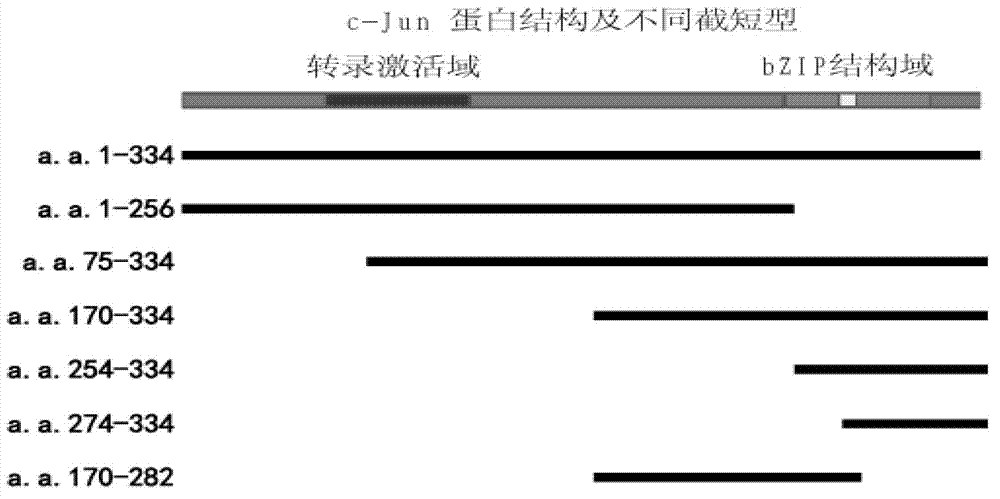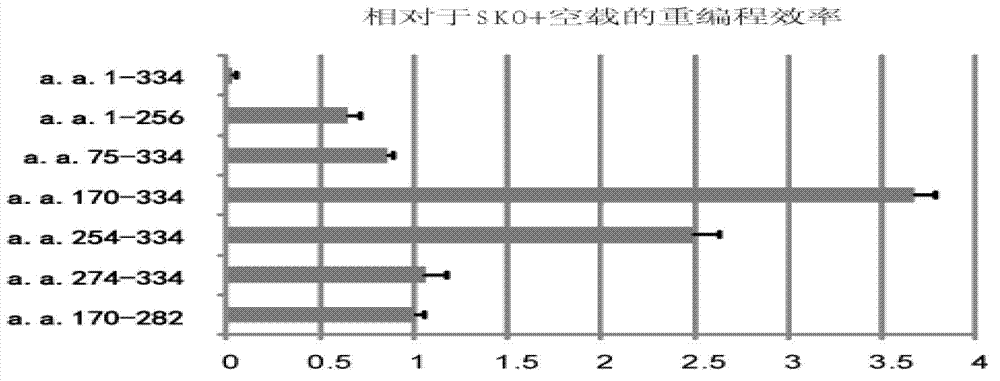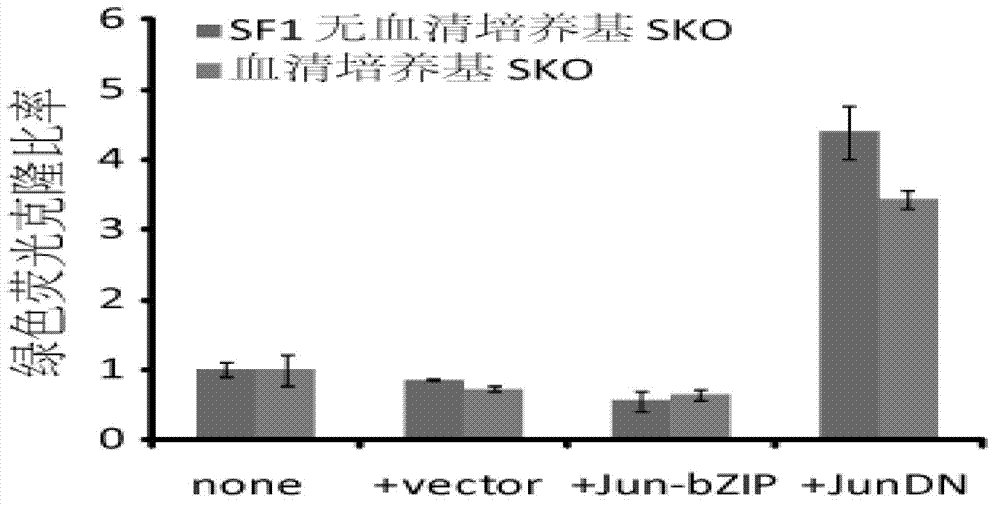Method of inducing pluripotent stem cells throuhg c-Jun N terminal deletion and applications
A technology for pluripotent stem cells and pluripotent stem cells, which is applied to cells modified by the introduction of foreign genetic material, recombinant DNA technology, and the use of vectors to introduce foreign genetic material, etc. question
- Summary
- Abstract
- Description
- Claims
- Application Information
AI Technical Summary
Problems solved by technology
Method used
Image
Examples
experiment example 1
[0071] Experimental Example 1: Construction of c-Jun and its different deletion types, c-Jun truncation promotes SKO-induced reprogramming efficiency.
[0072] Using conventional molecular cloning methods, the c-Jun protein full-length (324 amino acids), and 1-256, 75-324, 170-334, 254-334, 274-334, 170-334 and other 6 different amino acid fragments The nucleic acid sequence was cloned into the pMXs retroviral expression vector. Final cloned fragments such as figure 1 shown.
[0073] After the mouse fibroblasts were digested, 20,000 cells per well were planted in a 12-well plate, and infected with OKS or OKSM and the expression vector constructed in Example 1, respectively. After infection, culture with universal reprogramming medium, replace the medium every day, and count the number of fluorescent clones under a fluorescent microscope on appropriate days.
[0074] like figure 2 As shown, compared with empty load, the full length of C-Jun protein, the 1-256 fragment, and...
experiment example 2
[0075] Experimental example 2: c-Jun-DN promotes the reprogramming efficiency induced by SKO, and can replace the reprogramming factor Oct or Sox2.
[0076] MEF cells were infected with c-JunDN and three-factor SKO or different factor combinations respectively, and cultured in serum or serum-free induction culture system, the medium was changed every day and the reprogramming efficiency was calculated on appropriate days. To observe the effect of c-JunDN on reprogramming efficiency and its substitution effect on reprogramming factors.
[0077] The "serum-free medium SF1" described herein is the iPS-SF1 medium in the invention authorized by China with application number 200910038883.4. The serum medium described herein is a mouse embryonic stem cell culture medium well known to those skilled in the art, and its main components are basal medium supplemented with fetal bovine serum and leukocyte inhibitory factor LIF. The "serum medium" in this example is the mES medium in the i...
Embodiment 3
[0087] Example 3: c-Jun-DN can maintain the pluripotency of stem cells.
[0088] In order to study the role of C-Jun gene in the maintenance of pluripotency of embryonic stem cells, we studied the expression of this gene in the differentiation process of embryonic stem cells, adult cells and embryonic stem cells. Effects on functional maintenance and differentiation.
[0089] RNA was extracted from mouse embryonic fibroblasts (MEF) and embryonic stem cells (ES), and the expression of c-Jun in the two cells was analyzed by RT-PCR.
[0090] like Figure 11 It was shown that the expression level of c-Jun in MEF cells was much higher than that in embryonic stem cells. Indicating that c-Jun factor may be detrimental to the maintenance of pluripotency.
[0091] ES cells were differentiated into embryoid bodies (EBs) in a standard way, samples were collected at different days, RNA was extracted, and the expression of c-Jun in the two cells was analyzed by RT-PCR.
[0092] like ...
PUM
 Login to View More
Login to View More Abstract
Description
Claims
Application Information
 Login to View More
Login to View More - R&D
- Intellectual Property
- Life Sciences
- Materials
- Tech Scout
- Unparalleled Data Quality
- Higher Quality Content
- 60% Fewer Hallucinations
Browse by: Latest US Patents, China's latest patents, Technical Efficacy Thesaurus, Application Domain, Technology Topic, Popular Technical Reports.
© 2025 PatSnap. All rights reserved.Legal|Privacy policy|Modern Slavery Act Transparency Statement|Sitemap|About US| Contact US: help@patsnap.com



